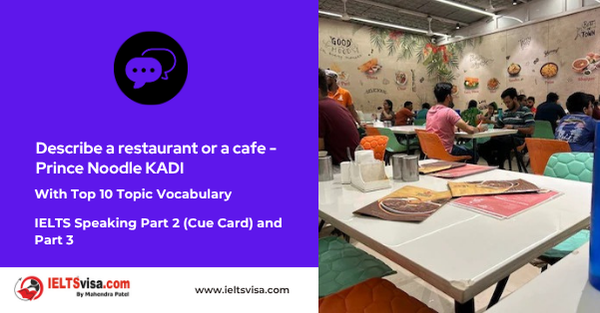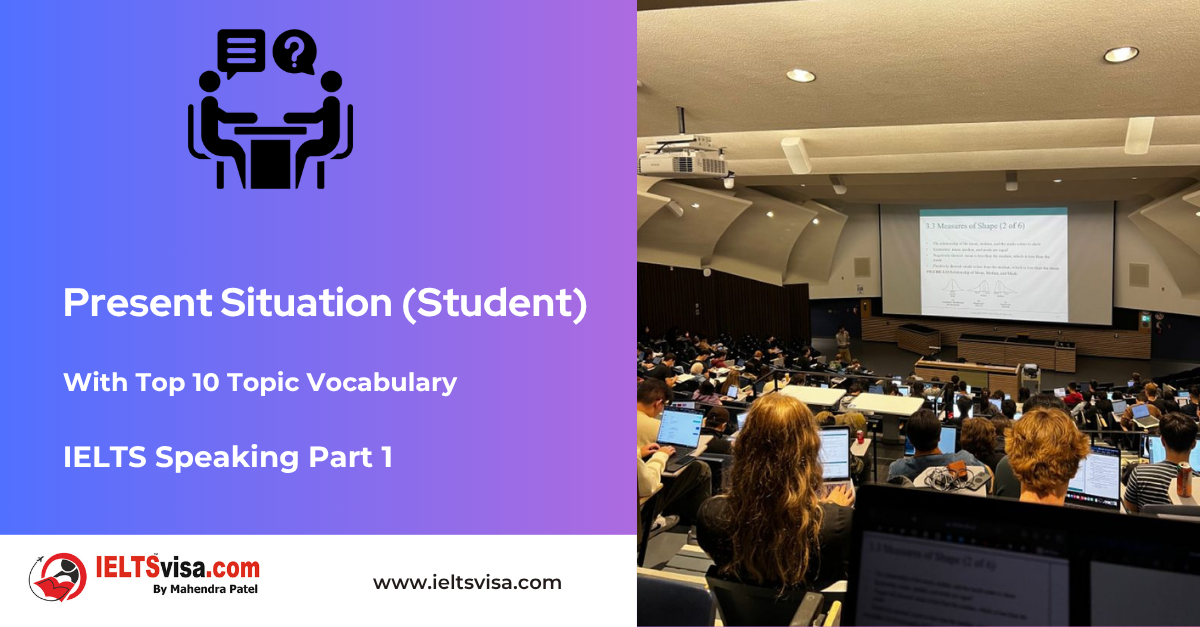Describe a restaurant or a cafe - Prince Noodle Restaurant.
IELTS Speaking Part 2 (Cue Card) Part 3: Follow-Up Questions
Describe a restaurant or a cafe – Prince Noodle Restaurant.
🗂️ Part 2 – Cue Card
Describe a restaurant or a cafe.
You should say:
- Where it is
- What it looks like
- What kind of services are provided
- What kind of food you like there/ What kind of food is famous?
- Why you like it
🗣️ Sample Answer
One of my favorite dining spots is Prince Noodle Restaurant, located in Kadi, Gujarat, India. This restaurant is a popular local spot known for its delightful selection of noodles and other Chinese dishes. Situated in a vibrant part of town, it’s easily recognisable by its charming, traditional Indian architecture combined with modern decor.
The restaurant boasts a cosy and inviting ambience, complete with warm lighting and comfortable seating arrangements. The interior features tasteful decor that blends Chinese and Indian influences, creating a unique and pleasant dining environment. There are both indoor and outdoor seating options, making it an ideal place for casual meals or special gatherings.
Prince Noodle Restaurant offers a range of services, including dine-in, takeout, and delivery. The staff is known for their friendly and attentive service, ensuring a great dining experience. They also provide customisable options for their dishes, allowing guests to adjust the spice levels and ingredients according to their preferences.
The restaurant is renowned for its delectable noodle dishes, including spicy Sichuan noodles and savoury chicken lo mein. I particularly enjoy their crispy spring rolls and the rich, flavorful hot and sour soup. The combination of authentic flavours and fresh ingredients makes the food at Prince Noodle Restaurant stand out.
I like Prince Noodle Restaurant not only for its delectable food but also for the warm and welcoming atmosphere. It’s a place where I can enjoy great meals with friends and family while experiencing a blend of cultural influences. The consistency in quality and service has made it a cherished spot for dining in Kadi.
🔁 Part 3: Follow-Up Questions
- Do you like cooking?
Yes, I enjoy cooking as it allows me to experiment with flavours and create dishes that suit my taste preferences. Cooking can be a relaxing and rewarding activity, and it also provides a sense of accomplishment when sharing meals with others.
- Will you cook for your friends when they visit you?
Absolutely. Cooking for friends is an excellent way to show hospitality and create memorable experiences. It’s also an opportunity to share favourite recipes and enjoy quality time together over a home-cooked meal.
- Who cooks in a Chinese family?
In traditional Chinese families, cooking responsibilities are often shared, with women traditionally taking on a larger role in meal preparation. However, modern Chinese families may have more varied arrangements, with both men and women contributing to cooking, especially in urban areas where both partners may work.
- What do you think of the advantages and disadvantages of fast food?
Advantages:
- Convenience: Fast food is quick and easy, making it a practical choice for busy lifestyles.
- Affordability: It is generally inexpensive compared to dining at a restaurant.
- Consistency: Fast food chains provide a consistent product, which can be comforting to consumers.
Disadvantages:
- Nutritional Value: Fast food is often high in calories, fat, and sodium, which can contribute to health problems.
- Quality: The quality of ingredients and preparation methods may be lower compared to freshly cooked meals.
- Addiction: The convenience and taste can lead to unhealthy eating habits and dependence on fast food.
- Why is fast food so popular?
Fast food is popular due to its convenience, affordability, and consistent taste. Busy schedules and the need for quick meal options contribute to its appeal. Marketing strategies and the proliferation of fast food outlets also play a significant role in its widespread popularity.
- Where would Chinese go when they eat out?
In China, dining options vary widely, including traditional restaurants, hot pot establishments, dim sum restaurants, and fast food chains. The choice of venue often depends on the type of cuisine desired, the occasion, and personal preferences.
- What changes would take place in terms of Chinese eating habits?
Chinese eating habits are evolving, with a growing emphasis on health-conscious choices and an increasing interest in international cuisine. There is an increasing trend towards organic and locally sourced ingredients, as well as a rise in the popularity of fast-casual dining options. Traditional family meals are also being supplemented with more diverse and convenient dining options.
- What food is popular?
Popular foods vary by region but often include dishes like dumplings, noodles, rice, hot pot, and various types of street food. In recent years, international cuisines and fusion dishes have also gained popularity in urban areas.
- What is the difference between fresh food and canned food?
Fresh Food:
- Quality: Typically retains more nutrients and better flavour.
- Taste: Often superior due to the absence of preservatives and minimal processing.
- Shelf Life: Shorter, requiring prompt consumption or proper storage.
Canned Food:
- Convenience: Longer shelf life and easy to store.
- Nutritional Value: May lose some nutrients during the canning process.
- Taste: Can sometimes be altered by preservatives and processing.
- What can we do to solve the problem of food shortage?
To address food shortages, strategies include improving agricultural practices, reducing food waste, enhancing food distribution systems, and promoting sustainable farming. Support for local food production and international aid efforts can also play a significant role in mitigating food scarcity.
- What are the advantages and disadvantages of family food?
Advantages:
- Nutritional Quality: Family meals are often home-cooked and can be healthier compared to fast food.
- Bonding: Sharing meals fosters family connections and provides opportunities for social interaction.
- Customisation: Meals can be tailored to individual dietary needs and preferences.
Disadvantages:
- Time-Consuming: Preparing family meals can be a time-consuming task.
- Variety: Limited variety compared to dining out or pre-prepared options.
- Cost: Home cooking can sometimes be more expensive, depending on the choice of ingredients and the complexity of the meal.
Top 10 Topic Vocabulary – Describe a restaurant or a cafe – Prince Noodle Restaurant.
|
Vocabulary |
Type |
Meaning |
Synonyms |
Antonyms |
Word Family |
|
Cozy |
Adjective |
Warm and comfortable, providing a feeling of relaxation |
Comfortable, Inviting |
Uncomfortable, Harsh |
Cosiness (Noun) |
|
Ambiance |
Noun |
The character or mood of a place or environment |
Atmosphere, Environment |
– |
Ambient (Adjective) |
|
Inviting |
Adjective |
Attractive or appealing in a way that draws people in |
Welcoming, Appealing |
Unwelcoming, Unappealing |
Invite (Verb) |
|
Customisable |
Adjective |
Capable of being modified to suit individual preferences |
Adjustable, Adaptable |
Fixed, Unchangeable |
Customise (Verb) |
|
Delectable |
Adjective |
Delicious, highly pleasing to taste |
Delicious, Mouth-watering |
Unappetising, Bland |
Delectability (Noun) |
|
Savory |
Adjective |
Pleasantly salty or spicy; not sweet |
Flavorful, Tasty |
Sweet, Bland |
Savoury (Noun) |
|
Crispy |
Adjective |
Having a firm, dry texture that breaks easily when bitten |
Crunchy, Crunchy |
Soggy, Soft |
Crisp (Adjective) |
|
Flavorful |
Adjective |
Full of flavour; rich in taste |
Tasty, Savoury |
Bland, Tasteless |
Flavour (Noun) |
|
Attentive |
Adjective |
Paying close attention to the needs of others |
Considerate, Mindful |
Neglectful, Unaware |
Attention (Noun) |
|
Consistency |
Noun |
The quality of always behaving or performing in the same way |
Reliability, Stability |
Inconsistency, Variability |
Consistent (Adjective) |
Set 2
|
Vocabulary |
Type |
Meaning |
Synonyms |
Antonyms |
Word Family |
|
Nutritional |
Adjective |
Relating to the nutrients in food and their effect on health |
Dietary, Healthful |
Unhealthy, Deficient |
Nutrition (Noun) |
|
Convenience |
Noun |
The state of being able to proceed with something without difficulty |
Ease, Accessibility |
Difficulty, Inconvenience |
Convenient (Adjective) |
|
Affordability |
Noun |
The quality of being inexpensive or within financial reach |
Cost-effectiveness, Budget-friendly |
Expensiveness, Overpriced |
Afford (Verb) |
|
Consistency |
Noun |
The quality of always behaving or performing in the same way |
Reliability, Uniformity |
Inconsistency, Variability |
Consistent (Adjective) |
|
Preservation |
Noun |
The action of maintaining something in its original state |
Protection, Conservation |
Neglect, Deterioration |
Preserve (Verb) |
|
Hospitality |
Noun |
The friendly and generous reception and entertainment of guests |
Welcome, Warmth |
Inhospitality, Coldness |
Hospitable (Adjective) |
|
Stereotype |
Noun |
A widely held but oversimplified and generalised belief about a particular group |
Generalisation, Prejudice |
Nuance, Individuality |
Stereotypical (Adjective) |
|
Sustainability |
Noun |
The ability to be maintained at a certain rate or level over the long term |
Viability, Durability |
Unsustainable, Wastefulness |
Sustainable (Adjective) |
|
Convenience |
Noun |
The quality of being easy to use or access |
Ease, Simplicity |
Difficulty, Complexity |
Convenient (Adjective) |
|
Diversity |
Noun |
The state of being diverse; variety |
Variety, Range |
Uniformity, Sameness |
Diverse (Adjective) |

Our Books
Master IELTS Speaking Part 1
IELTS Writing Task 1 Book
IELTS Writing Task 2 Book
Practice IELTS Other Modules
IELTS Listening
The IELTS Listening test assesses how well you can understand spoken English in various contexts. It lasts about 30 minutes and is divided into four sections with a total of 40 questions. The listening tasks become increasingly difficult as the test progresses.
IELTS Academic Reading
The IELTS Academic Reading section assesses your ability to understand and interpret a variety of texts in academic settings. It is designed to evaluate a range of reading skills, including skimming for gist, reading for main ideas, reading for detail, understanding inferences, and recognizing a writer's opinions and arguments.
IELTS Speaking
The IELTS Speaking test assesses your ability to communicate in English on everyday topics. It lasts 11-14 minutes and consists of three parts: introduction, cue card, and a discussion based on the cue card topic.
IELTS General Reading
IELTS General Reading tests your ability to understand and interpret various types of texts. Here are some key areas and types of content you can expect to encounter in the reading section, along with tips for effective preparation.
IELTS Academic Writing Task 1
In IELTS Academic Writing Task 1, you are presented with a visual representation of information, such as graphs, charts, tables, or diagrams, and you are required to summarize, compare, or explain the data in your own words.
IELTS General Writing Task 1
In IELTS General Writing Task 1, you are required to write a letter based on a given situation. The letter can be formal, semi-formal, or informal, depending on the prompt. Here’s a breakdown of the key components to include in your letter
IELTS Academic Writing Task 2
In IELTS Academic Writing Task 2, you are required to write an essay in response to a question or topic. Here’s a guide to help you understand the essential elements of this task
IELTS Exam Tips
To succeed in the IELTS exam, practice regularly, familiarize yourself with the test format, improve your vocabulary, develop time management skills, and take mock tests to build confidence.
Grammer for IELTS
Grammar is the foundation of effective communication in English. Understanding tense usage, subject-verb agreement, and sentence structure enhances clarity and coherence in writing and speaking.
Vocabulary for IELTS
Vocabulary plays a crucial role in the IELTS (International English Language Testing System) exam, especially in the Speaking and Writing sections. Here’s an overview of why vocabulary is important and how it impacts your performance
RECENT IELTS SAMPLES QUESTIONS AND ANSWERS
IELTS Speaking Part 1 – Favourite Sujbect – Physics
IELTS Speaking Part 1 - Favourite Sujbect - Physics Q: What is your favourite subject? A: My favourite subject...
IELTS Speaking Part 1 – Present Situation (Student)
IELTS Speaking Part 1 - Present Situation (Student) Q1: Are you a student or do you work?A: I’m a full-time...
IELTS Speaking Part 1 – Present Situation – Employee – as an International Student and Social Worker
IELTS Speaking Part 1 - Present Situation - Employee - as an International Student and Social Worker Q1: Are...
IELTS Speaking Part 1 – Persent Situation – Employee- as an Electric Engineer
IELTS Speaking Part 1 - Persent Situation - Employee- as an Electric Engineer Q1: What do you do for a...
IELTS Speaking Part 1 – Persent Situation – Employee – as an Software Engineer
IELTS Speaking Part 1 - Persent Situation - Employee - as an Software Engineer Q1: What do you do for a...
IELTS Speaking Part 1 – Persent Situation – Married
IELTS Speaking Part 1 - Persent Situation - Married Q1: Are you married?A: Yes, I am married. My spouse and I...













